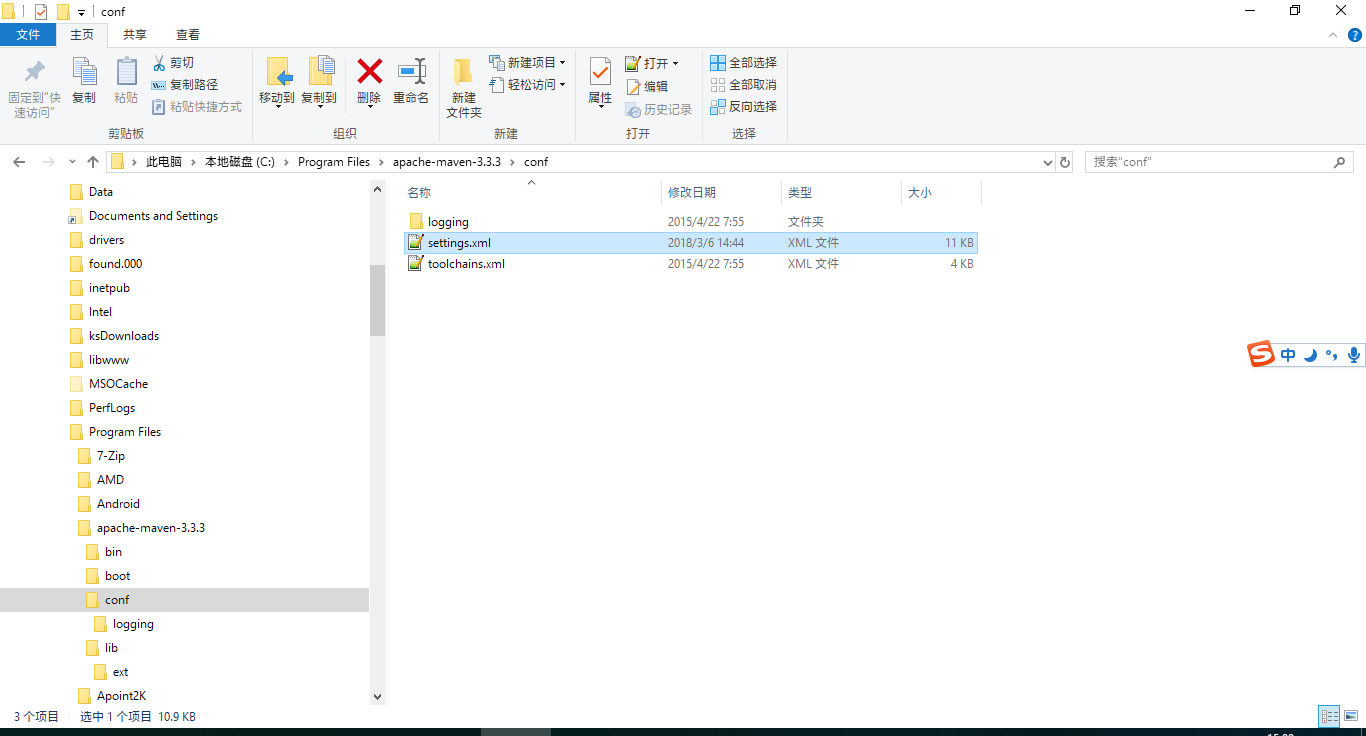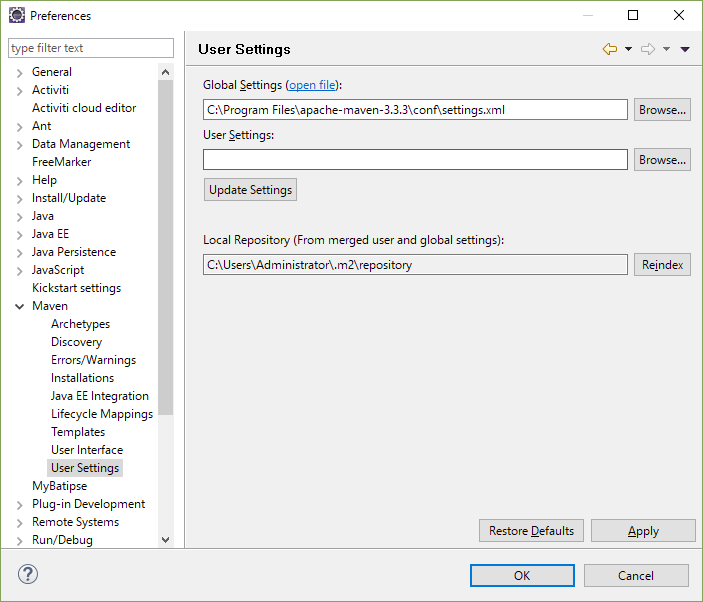Maven 3.3全局配置
Maven采用全局配置的方案:



<?xml version="1.0" encoding="UTF-8"?> <!--
Licensed to the Apache Software Foundation (ASF) under one
or more contributor license agreements. See the NOTICE file
distributed with this work for additional information
regarding copyright ownership. The ASF licenses this file
to you under the Apache License, Version 2.0 (the
"License"); you may not use this file except in compliance
with the License. You may obtain a copy of the License at http://www.apache.org/licenses/LICENSE-2.0 Unless required by applicable law or agreed to in writing,
software distributed under the License is distributed on an
"AS IS" BASIS, WITHOUT WARRANTIES OR CONDITIONS OF ANY
KIND, either express or implied. See the License for the
specific language governing permissions and limitations
under the License.
--> <!--
| This is the configuration file for Maven. It can be specified at two levels:
|
| 1. User Level. This settings.xml file provides configuration for a single user,
| and is normally provided in ${user.home}/.m2/settings.xml.
|
| NOTE: This location can be overridden with the CLI option:
|
| -s /path/to/user/settings.xml
|
| 2. Global Level. This settings.xml file provides configuration for all Maven
| users on a machine (assuming they're all using the same Maven
| installation). It's normally provided in
| ${maven.home}/conf/settings.xml.
|
| NOTE: This location can be overridden with the CLI option:
|
| -gs /path/to/global/settings.xml
|
| The sections in this sample file are intended to give you a running start at
| getting the most out of your Maven installation. Where appropriate, the default
| values (values used when the setting is not specified) are provided.
|
|-->
<settings xmlns="http://maven.apache.org/SETTINGS/1.0.0"
xmlns:xsi="http://www.w3.org/2001/XMLSchema-instance"
xsi:schemaLocation="http://maven.apache.org/SETTINGS/1.0.0 http://maven.apache.org/xsd/settings-1.0.0.xsd">
<!-- localRepository
| The path to the local repository maven will use to store artifacts.
|
| Default: ${user.home}/.m2/repository-->
<localRepository>C:\Users\Administrator\.m2\repository</localRepository> <!-- interactiveMode
| This will determine whether maven prompts you when it needs input. If set to false,
| maven will use a sensible default value, perhaps based on some other setting, for
| the parameter in question.
|
| Default: true
<interactiveMode>true</interactiveMode>
--> <!-- offline
| Determines whether maven should attempt to connect to the network when executing a build.
| This will have an effect on artifact downloads, artifact deployment, and others.
|
| Default: false
<offline>false</offline>
--> <!-- pluginGroups
| This is a list of additional group identifiers that will be searched when resolving plugins by their prefix, i.e.
| when invoking a command line like "mvn prefix:goal". Maven will automatically add the group identifiers
| "org.apache.maven.plugins" and "org.codehaus.mojo" if these are not already contained in the list.
|-->
<pluginGroups>
<!-- pluginGroup
| Specifies a further group identifier to use for plugin lookup.
<pluginGroup>com.your.plugins</pluginGroup>
-->
</pluginGroups> <!-- proxies
| This is a list of proxies which can be used on this machine to connect to the network.
| Unless otherwise specified (by system property or command-line switch), the first proxy
| specification in this list marked as active will be used.
|-->
<proxies>
<!-- proxy
| Specification for one proxy, to be used in connecting to the network.
|
<proxy>
<id>optional</id>
<active>true</active>
<protocol>http</protocol>
<username>proxyuser</username>
<password>proxypass</password>
<host>proxy.host.net</host>
<port>80</port>
<nonProxyHosts>local.net|some.host.com</nonProxyHosts>
</proxy>
-->
</proxies> <!-- servers
| This is a list of authentication profiles, keyed by the server-id used within the system.
| Authentication profiles can be used whenever maven must make a connection to a remote server.
|-->
<servers>
<!-- server
| Specifies the authentication information to use when connecting to a particular server, identified by
| a unique name within the system (referred to by the 'id' attribute below).
|
| NOTE: You should either specify username/password OR privateKey/passphrase, since these pairings are
| used together.
|
<server>
<id>deploymentRepo</id>
<username>repouser</username>
<password>repopwd</password>
</server>
--> <!-- Another sample, using keys to authenticate.-->
<server>
<id>nexus-releases</id>
<username>admin</username>
<password>admin123</password>
</server>
<server>
<id>nexus-snapshots</id>
<username>admin</username>
<password>admin123</password>
</server> </servers> <!-- mirrors
| This is a list of mirrors to be used in downloading artifacts from remote repositories.
|
| It works like this: a POM may declare a repository to use in resolving certain artifacts.
| However, this repository may have problems with heavy traffic at times, so people have mirrored
| it to several places.
|
| That repository definition will have a unique id, so we can create a mirror reference for that
| repository, to be used as an alternate download site. The mirror site will be the preferred
| server for that repository.
|-->
<mirrors>
<!-- mirror
| Specifies a repository mirror site to use instead of a given repository. The repository that
| this mirror serves has an ID that matches the mirrorOf element of this mirror. IDs are used
| for inheritance and direct lookup purposes, and must be unique across the set of mirrors.
| -->
<mirror>
<id>offical</id>
<name>Maven Official Repository</name>
<url>http://repo1.maven.org/maven2</url>
<mirrorOf>central</mirrorOf>
</mirror>
<mirror>
<id>jboss</id>
<name>Jboss Repository</name>
<url>http://repository.jboss.org/nexus/content/groups/public-jboss/</url>
<mirrorOf>central</mirrorOf>
</mirror>
<mirror>
<id>AsposeJavaAPI</id>
<name>Aspose Java API</name>
<url>http://maven.aspose.com/repository/repo</url>
<mirrorOf>*</mirrorOf>
</mirror>
<mirror>
<id>mvn</id>
<name>Mvn Repository</name>
<url>https://mvnrepository.com/</url>
<mirrorOf>central</mirrorOf>
</mirror>
</mirrors> <!-- profiles
| This is a list of profiles which can be activated in a variety of ways, and which can modify
| the build process. Profiles provided in the settings.xml are intended to provide local machine-
| specific paths and repository locations which allow the build to work in the local environment.
|
| For example, if you have an integration testing plugin - like cactus - that needs to know where
| your Tomcat instance is installed, you can provide a variable here such that the variable is
| dereferenced during the build process to configure the cactus plugin.
|
| As noted above, profiles can be activated in a variety of ways. One way - the activeProfiles
| section of this document (settings.xml) - will be discussed later. Another way essentially
| relies on the detection of a system property, either matching a particular value for the property,
| or merely testing its existence. Profiles can also be activated by JDK version prefix, where a
| value of '1.4' might activate a profile when the build is executed on a JDK version of '1.4.2_07'.
| Finally, the list of active profiles can be specified directly from the command line.
|
| NOTE: For profiles defined in the settings.xml, you are restricted to specifying only artifact
| repositories, plugin repositories, and free-form properties to be used as configuration
| variables for plugins in the POM.
|
|-->
<profiles>
<!-- profile
| Specifies a set of introductions to the build process, to be activated using one or more of the
| mechanisms described above. For inheritance purposes, and to activate profiles via <activatedProfiles/>
| or the command line, profiles have to have an ID that is unique.
|
| An encouraged best practice for profile identification is to use a consistent naming convention
| for profiles, such as 'env-dev', 'env-test', 'env-production', 'user-jdcasey', 'user-brett', etc.
| This will make it more intuitive to understand what the set of introduced profiles is attempting
| to accomplish, particularly when you only have a list of profile id's for debug.
|
| This profile example uses the JDK version to trigger activation, and provides a JDK-specific repo.
<profile>
<id>jdk-1.4</id> <activation>
<jdk>1.4</jdk>
</activation> <repositories>
<repository>
<id>jdk14</id>
<name>Repository for JDK 1.4 builds</name>
<url>http://www.myhost.com/maven/jdk14</url>
<layout>default</layout>
<snapshotPolicy>always</snapshotPolicy>
</repository>
</repositories>
</profile>
--> <!--
| Here is another profile, activated by the system property 'target-env' with a value of 'dev',
| which provides a specific path to the Tomcat instance. To use this, your plugin configuration
| might hypothetically look like:
|
| ...
| <plugin>
| <groupId>org.myco.myplugins</groupId>
| <artifactId>myplugin</artifactId>
|
| <configuration>
| <tomcatLocation>${tomcatPath}</tomcatLocation>
| </configuration>
| </plugin>
| ...
|
| NOTE: If you just wanted to inject this configuration whenever someone set 'target-env' to
| anything, you could just leave off the <value/> inside the activation-property.
|
<profile>
<id>env-dev</id> <activation>
<property>
<name>target-env</name>
<value>dev</value>
</property>
</activation> <properties>
<tomcatPath>/path/to/tomcat/instance</tomcatPath>
</properties>
</profile>
-->
<profile>
<id>dev</id>
<repositories>
<repository>
<id>local-nexus</id>
<url>http://192.168.110.225:8081/nexus/content/groups/public</url>
<releases>
<enabled>true</enabled>
</releases>
<snapshots>
<enabled>true</enabled>
</snapshots>
</repository>
</repositories>
</profile>
<!-- Ƥ׃Ѿ֘Ӗࠢ -->
</profiles> <!-- ǴԃѾ֘Ӗࠢ -->
<activeProfiles>
<activeProfile>dev</activeProfile>
</activeProfiles> <!-- activeProfiles
| List of profiles that are active for all builds.
|
<activeProfiles>
<activeProfile>alwaysActiveProfile</activeProfile>
<activeProfile>anotherAlwaysActiveProfile</activeProfile>
</activeProfiles>
-->
</settings>
Maven 3.3全局配置的更多相关文章
- Maven使用(一)—— Maven的安装与全局配置
一.Maven安装 Maven的安装步骤: 1.Maven官网(http://maven.apache.org/)下载压缩包,解压缩,当前最新版本是apache-maven-3.5.3-bin.zip ...
- maven工程指定jdk版本,maven全局配置jdk的版本
- IDEA修改Maven全局配置
在使用过程中发现,IDEA每次新建一个Project ,这个maven配置都会初始化默认的. 这里需要设置下全局配置: File -> Other Settings -> Settings ...
- Maven的安装、配置及使用入门
Maven的安装.配置及使用入门 本书代码下载 大家可以从我的网站下载本书的代码:http://www.juvenxu.com/mvn-in-action/,也可以通过我的网站与我取得联系,欢迎大家与 ...
- 1.Maven的安装及配置
1 Maven 介绍 Maven这个词可以翻译为“知识的积累”,也可以翻译为“专家”或“内行”.本书将介绍Maven这一跨平台的项目管理工具.作为Apache组织中的一个颇为成功的开源项目,Maven ...
- Apache Maven 3.6.1配置安装
Apache Maven 3.6.1配置安装 一.下载 maven下载地址:http://maven.apache.org/download.cgi 二.安装 1,解压即可用 2,环境变量配置 MAV ...
- 架构(二)Maven安装以及Nexus配置
一 Maven安装配置 1.1 下载 http://mirrors.tuna.tsinghua.edu.cn/apache/maven/maven-3/3.5.4/binaries/apache-ma ...
- Jenkins Jenkins结合GIT Maven持续集成环境配置
Jenkins结合GIT Maven持续集成环境配置 by:授客 QQ:1033553122 安装Git插件 1 安装Git客户端 1 安装JAVA JDK及MAVEN 2 Jenkins JDK ...
- Java开发环境配置(4)--Maven安装 环境变量配置,本地仓库配置---插件安装
说明在前:本人用过的 luna mars 等,都已经自带maven插件的了,以下有些文章是很老的,讲到maven插件的安装都可以忽略掉. maven安装eclipse在线配置maven搞定所有插件_ ...
随机推荐
- python 之 初识面向对象
编程的两种范式 我们知道,程序 = 特定的语法+数据结构+算法 好像这个和我们熟知的小说有类似之处啊,小说 = 人物+背景+情节 写小说呢,都是有模板的,so,写程序也是一样,我们把这个“模板”叫做编 ...
- swift的类型描述符
Metatype Types A concrete or existential metatype in SIL must describe its representation. This can ...
- [Noi2002]Savage(欧几里得拓展)
题意:在一个岛上,有n个野人.这些人开始住在c号洞穴,每一年走p个洞,而且他的生命有L年.问如果岛上的洞穴为一个圈,那么这个圈至少有多少个,才能使他们每年都不在同一个洞穴里. 分析:先假设一种简单的情 ...
- M600 (1)飞行注意事项
- 【转】Emgu 图像阈值
原文地址:http://www.cnblogs.com/CoverCat/p/5043833.html 转载,备查 Visual Studio Community 2015 工程和代码:http:// ...
- 如何在自己设计的页面中调用metamask-2
参考: 1)https://www.colabug.com/3204345.html 2)https://www.toptal.com/ethereum/one-click-login-flows-a ...
- 【Codeforces Round 725】Canada Cup 2016
模拟Canada Cup 2016,ABC三题,Rank1376 第三题卡住了 Codeforces 725 C 求出两个相同字符的位置,记为x和y. 然后考虑把相同的那个字符放在第一行的什么地方, ...
- BZOJ1767/Gym207383I CEOI2009 Harbingers 斜率优化、可持久化单调栈、二分
传送门--BZOJCH 传送门--VJ 注:本题在BZOJ上是权限题,在Gym里面也不能直接看,所以只能在VJ上交了-- 不难考虑到这是一个\(dp\). 设\(dep_x\)表示\(x\)在树上的带 ...
- WebApi 接口返回值不困惑:返回值类型详解。IHttpActionResult、void、HttpResponseMessage、自定义类型
首先声明,我还没有这么强大的功底,只是感觉博主写的很好,就做了一个复制,请别因为这个鄙视我,博主网址:http://www.cnblogs.com/landeanfen/p/5501487.html ...
- html table隐藏列
隐藏table表的第一列,适合显示信息,隐藏ID主键. <html> <head> <meta http-equiv="content-type" c ...
